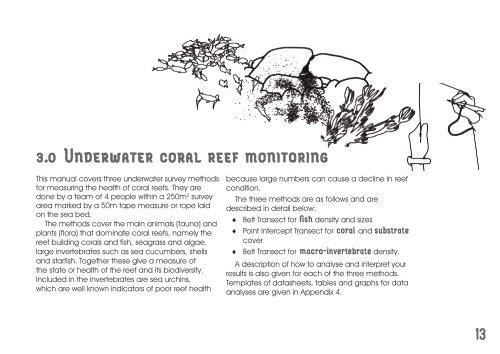TNC-CORDIO coral reef monitoring manual_book_coral1
TNC-CORDIO coral reef monitoring manual_book_coral1
TNC-CORDIO coral reef monitoring manual_book_coral1
Create successful ePaper yourself
Turn your PDF publications into a flip-book with our unique Google optimized e-Paper software.
3.0 Underwater <strong>coral</strong> <strong>reef</strong> <strong>monitoring</strong><br />
This <strong>manual</strong> covers three underwater survey methods<br />
for measuring the health of <strong>coral</strong> <strong>reef</strong>s. They are<br />
done by a team of 4 people within a 250m 2 survey<br />
area marked by a 50m tape measure or rope laid<br />
on the sea bed.<br />
The methods cover the main animals (fauna) and<br />
plants (flora) that dominate <strong>coral</strong> <strong>reef</strong>s, namely the<br />
<strong>reef</strong> building <strong>coral</strong>s and fish, seagrass and algae,<br />
large invertebrates such as sea cucumbers, shells<br />
and starfish. Together these give a measure of<br />
the state or health of the <strong>reef</strong> and its biodiversity.<br />
Included in the invertebrates are sea urchins,<br />
which are well known indicators of poor <strong>reef</strong> health<br />
because large numbers can cause a decline in <strong>reef</strong><br />
condition.<br />
The three methods are as follows and are<br />
described in detail below:<br />
♦♦<br />
♦♦<br />
♦♦<br />
Belt Transect for fish density and sizes<br />
Point Intercept Transect for <strong>coral</strong> and substrate<br />
cover<br />
Belt Transect for macro-invertebrate density.<br />
A description of how to analyse and interpret your<br />
results is also given for each of the three methods.<br />
Templates of datasheets, tables and graphs for data<br />
analyses are given in Appendix 4.<br />
13


















